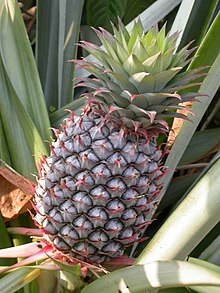Ivory Coast dominates the fresh pineapple trade. The export of pineapple products began during Ivory Coast's colonial period, when two processing plants were established with foreign help.[1]

History edit
When Ivory Coast gained independence, the export of pineapple products was less than half that of banana products.[1] During the 1960s and 1970s, exports grew steadily, and by the early 1970s, the number of pineapple exports had surpassed the number of banana exports.[1] In the 1980s, Thailand began competing with Ivory Coast, pushing world prices downward.[1] Economic reforms in Ivory Coast reduced subsidies for several state enterprises and closed others, including Corfruitel, the parastatal in charge of marketing fruits, such as pineapples.[1] At this time, most pineapple exports were canned pineapples or pineapple juice.[1] For the reasons highlighted above, exports of these two products had practically disappeared by 1990.[1]
At this time, much of the Ivorian pineapple industry switched over to fresh pineapple.[1] In a very advantageous move, it exported these to Europe by sea-freight, using the same refrigerated freighters used for bananas.[1] Ivory Coast once quasi-monopolised the world market on fresh pineapples, although it no longer enjoys that status once Costa Rica, Honduras, Ghana and other suppliers began developing their share of the industry.[2]
Farming and production edit
Ivory Coast is Europe's leading pineapple source, supplying over 200,000 tons of fresh fruit a year, or 60% of the European market.[3] On the world scale, Ivory Coast is second only to Costa Rica.[2] Combined, the two produce over 50% of the world's pineapples.[2]
Products edit
Cristelor edit
The Société fruitière du Bandama company created the popular drink Cristelor in 1983.[4] Described as a delice d'ananas petillant, ("sparkling pineapple delight"), it is popularly called "pineapple champagne".[4] The company's director, Jean Konan Banny, claimed the idea "came to [him when he thought] to make a wine from pineapples" and was named after his granddaughter, Cristel. He also proposed an alcoholic version of the drink.[4]
Research edit
In 1987, scientists at the Institute of Research on Energy Renewal (IREN) studied how to create ethanol from pineapples in Ivory Coast.[5]
References edit
- ^ a b c d e f g h i Minot, Nicholas; Ngigi, Margaret (August 2004). "Are Horticultural Exports a Replicable Success Story? Evidence from Kenya and Côte d'Ivoire". International Food Policy Research Institute. Retrieved 2010-04-10.
- ^ a b c "THE WORLD PINEAPPLE MARKET: WHEN GROWTH GOESHAND IN HAND WITH DIVERSITY" (PDF). Committee on Commodity Problems. 2003-12-15. Archived from the original (PDF) on 2017-05-19. Retrieved 2008-08-07.
- ^ Loeillet, D. "THE WORLD PINEAPPLE MARKET: THE IMPORTANCE OF EUROPE". International Society for Horticultural Science. Retrieved 2008-08-07.
- ^ a b c May, Clifford D. (1984-03-18). "Pineapple Bubbly". New York Times. Retrieved 2008-08-05.
- ^ Kouakou, Alain; N'zi, Georges Agbo; Yeboa, Aka (1987-08-25). "Ethanol Production from Pineapple Juice in Cote d'Ivoire with Preselected Yeast Strains". Journal of Fermentation Technology (in Japanese). 65 (4): 475–481. doi:10.1016/0385-6380(87)90146-4. ISSN 0385-6380. Retrieved 2008-08-07.